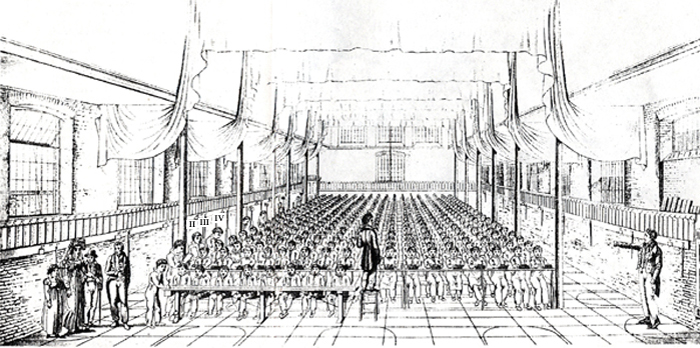

A Lancastrian (Joseph Lancaster, 1778-1838) model school, the Borough Road School of the British and Foreign Schools Society, at the beginning of the nineteenth century (at the peak of the Industrial Revolution). It is such schools as these that Charles Dickens depicted in his novel "Hard Times" (1854). The master stands on the extreme right. At the front of the school stands the 'monitor of order', whose task is to control the 350 or so boys in the school, who are shown here sitting at their writing desks. At the end of each row stands a 'monitor of class'. Each row, or class, is identified by a card placed on an upright standard, numbered from I to VIII. The term 'standard', which from 1862 became the universal name for a class, may derive partly from this practice. Around the walls are placed 'lessons' pasted to pieces of board, something like the hornbooks of an earlier period or the worksheets of our own day. Beneath the boards are wooden pointers which would be used by monitors when giving their instruction. At such times the children (drawn from the impoverished) being taught would stand at their 'draft station', a semicircle marked on the floor, facing the wall. The ceiling curtains are not for aesthetic effect, but to help deaden the noise that such large congregations of children created.
As an educated person, Esther wanted to understand authors such as Charles Dickens, and the London of Charles Dickens' works. Such knowledge could be gained by reading books written by such people as Henry Mayhew ("London Labor and the London Poor" and "The London Underworld in the Victorian Period"), and also by understanding the Victorian environment, which was one highly affected by the Industrial Revolution. Esther Lederberg's primary interest, however, was the human element that was so well-described by Charles Dickens and his wonderful character portraits.
Esther and her second husband both loved Dickens because he showed good, honest people (often impoverished) as well as evil, destructive people. For all of Dickens' shortcomings, this was one of his achievements.
Esther loved to read, starting at an early age. As Esther's parents were not at all wealthy, a book was a prized possession. Esther was quite aware of the injustices in this world. With Esther's love of languages, it was only inevitable that Esther would appreciate the books of Charles Dickens (as well as other authors such as Shakespeare, Trollope, Austen, etc).
© Copyright 2006 - 2018
The Esther M. Zimmer Lederberg Trust
 Website Terms of Use
Website Terms of Use